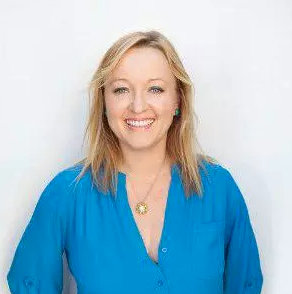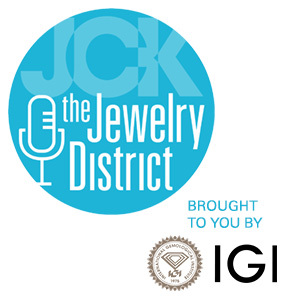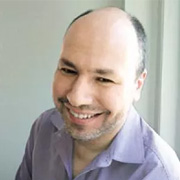
In 2018, Anna Harman decided it was time to up her ear game, so she stopped by a high-end jewelry boutique in New York City to add a piercing. The experience left quite a bit to be desired, but it sent her on a deep dive into the ear-piercing market, and led her and her cofounder, Lisa Bubbers, to open their first Studs “studio” on Prince Street in Manhattan’s Nolita neighborhood in 2019.

“Our second store was at the original Hudson Yards, which opened two weeks before COVID and then promptly closed for six months,” Harman, 40, tells JCK on a recent video call from her office in Soho. “Now, Hudson Yards is like a giant flagship store, and it has the most traffic of any of the New York City stores.”
The Studs empire currently comprises 33 stores across the country (by year’s end, the plan is to have 40), each decorated in the brand’s white and lemon-yellow color scheme. Studs provides sterile needle-only piercings using an appealing selection of earring styles as part of its mission to target “the post-Claire’s customer.”

“Our customer has on average between five and nine piercings,” Harman says. “We’re really focused on a second piercing and beyond customer. It was always a trend, but it became more accessible through time.”
Below, Harman explains how she lucked into the category, why needles provide better piercings than guns, and why she doesn’t see the need to expand into other types of jewelry.
What’s your background? And what were you doing prior to 2019 when you had the idea for Studs?
I went to Princeton for undergrad. I then graduated and went to BU [Boston University] for law school. I practiced as an attorney after law school for almost two years in a highly boring area of the law, mutual fund formation. Extremely boring. And I then went to work at Bridgewater Associates, a very large asset manager in Connecticut. I did that for almost five years. I loved the firm, but I didn’t love the sector.
I left to work in a series of startups in New York, most of which were consumer-facing services-oriented startups. And I began thinking about starting a company while I was at the last of those startups, a company called Jetblack, which was a text-to-shop service that Walmart had incubated. I was thinking about starting a company and experimenting with a lot of different ideas, but then randomly went to go get an ear piercing and just had a very sort of bizarre experience.
I went to a very premium place in New York where I was going to have to wait two hours. They didn’t even take appointments. I would have spent $750. And I ended up leaving and went to a tattoo parlor to get pierced. The piercing experience was great. I really liked my piercer. But the jewelry was horrible. And the environment was so ill-suited to me. I was sort of like, “What am I doing here?” And I started to do some research to understand what had ever happened to Claire’s, and Claire’s competitor, now Banter by Piercing Pagoda. And I learned that both were and are really great businesses. Claire’s has suffered from, I think, challenging management from a debt perspective. But the fundamentals were very strong in both businesses.
You opened your first store in 2019 and your second store just before the start of the pandemic. What was that period like for the business?
It was very challenging in the sense that we were off to a very strong start. We had two studios. We had lines out the door at our Nolita store every single weekend. We had strong product-market fit. You’re going 100 miles per hour and you have to stomp on the brakes, which we did. We spent the next, I would say, year and a half, but certainly the next six months, very, very highly focused on e-comm and built that business out of necessity.
We had no choice but to really focus on it and try and get to a point where we were deriving significant revenue from it because prior to COVID, almost all of our revenue had come from the two studios we had opened. And there was, I think, real value in that year and a half of building that muscle for e-commerce and figuring out what was the site experience supposed to be, and how do people want to shop with us if they’re shopping online, what product assortment are they looking for, etc.
And then we started meaningfully reopening and building stores in ’22 and beyond. And the focus has since really shifted. I would say, since ’22, this is predominantly a studios business. E-commerce is obviously a component of what we do, but we are a stores business first and foremost.
Part of the distinction of the Studs piercing experience is that your piercers only work with needles, not guns. Why was that important to you?
Getting your ear pierced with a gun is like putting a three-hole punch through your ear. It forces the tissue backwards. Needles are much more precise. They also allow you to do much more intricate piercings up the ear that guns can’t even ergonomically do. The gun also is made of plastic. And so while you can put sterile jewelry into it, the components of the gun cannot be sterilized. And all of our jewelry and all of our tools, our needles, everything we use to pierce you is all pre-sterilized. So you’re just having a much more sterile experience, which obviously results in better outcomes.

You’ve trademarked the term earscaping. When did you realize this concept of the “curated ear” had legs?
In a practical sense, this is a very, very old phenomenon. If you look at paintings and Egyptian hieroglyphics, women have been wearing multiple earrings for quite some time. So I don’t think any of us should claim that we invented the idea of multiple piercings and wearing multiple earrings. As workplace dress norms have changed, I think earscaping as a general point has become much more prominent.
For reference, I had my cartilage pierced when I was in high school. After I graduated law school, my mom was like, “You cannot possibly go to your law firm having that cartilage earring in.” Just think about that now—that would never occur today, right? Even over the last 15 years, things have changed so substantially that what was already a trend just became a thing that it was much more accessible to do no matter what workplace you were in.
Who is the Studs customer?
Our core customer is 18 to 35. We are really talking about a second piercing and beyond customer. We only pierce over age 13. So while we, of course, have people that are getting first lobes, it’s not the bread and butter of our business.
The brand, from a look and feel perspective, is positioned as a Gen Z and young millennial brand. Claire’s, obviously, is a beloved brand for little kids and tweens, but doesn’t really have a graduation opportunity beyond that.

Do you envision expanding into other types of jewelry beyond earrings?
We’re all ears. It’s not that I don’t think we might do that well. It’s that I don’t think the customer wants that from us. In practice, Studs is an ear-piercing brand—ear piercings to wear earrings, and that’s why we sell them. But I don’t think they are conceiving of Studs at all as a bracelet and ring brand.
Tell us about your earring selection.
I think everybody thinks of piercing jewelry and they think of little gold balls, right? We were really determined to have actually cute piercing jewelry that you would want to keep in your ears for a fair bit of time that felt either like a form of self-expression for you or, at a minimum, aligned with your style.
When I went to the tattoo parlor—it’s funny because I remember it really vividly, both because I started this business, but also because I really didn’t like it—I got this white gold bar that I would just never wear, but it was sort of the best of the options that they had in a really limited selection. We were determined to have a wide selection, wide price point availability, and that the stuff was all going to be very cute. And that is pretty uncommon in the piercing industry.
What is the opening price point and where does it top out? And what are the materials?
Opening price point is $35 and starts with all-titanium product. And then we go up as high as $200-plus and sell diamonds. All lab-grown. Titanium and 14k, nothing else, for the piercing jewelry specifically. For the fashion jewelry, we work in a variety of metals.
Got it. In terms of growth opportunities or how you see the business evolving, are you primarily opening more locations, or are there other options for growth?
I’m very interested right now in continuing to expand the store footprint. We’ll end at over 40 this year and then are looking forward to 50 and beyond.

If someone had told you 25 years ago that you’d be CEO of a piercing business, would you have believed them?
I definitely didn’t imagine it. My mom, she’s like, “No way.” But if you had asked me when I was 25, I would have been like, “Good idea. I’ll start it earlier.”
Top: Studs trademarked the term earscape, which it defines as “the art and science of personalized ear piercings and earring stacking, resulting in a form of unique self-expression.” (All photos courtesy of Studs)
- Subscribe to the JCK News Daily
- Subscribe to the JCK Special Report
- Follow JCK on Instagram: @jckmagazine
- Follow JCK on X: @jckmagazine
- Follow JCK on Facebook: @jckmagazine






